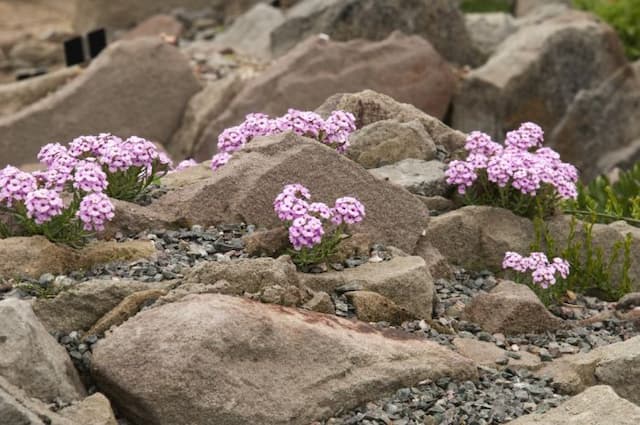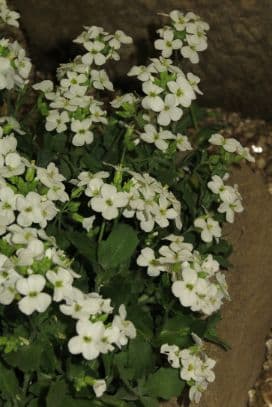Woad Isatis tinctoria

ABOUT
Isatis tinctoria, more commonly known as woad, is a flowering plant whose appearance is characterized by its robust nature and a basal rosette of leaves during its first year of growth. These leaves are lanceolate-shaped, meaning they are lance-like with a broader base tapering to a point. The leaves are bluish-green in color, and the plant has a distinctive powdery texture. In its second year, woad produces upright flowering stems that are branched and bear more leaves. These stem leaves are smaller than the basal leaves and alternate along the stem, clasping it at the base. The flowers are small and yellow, clustered in rounded heads that look like bunches atop the branches. The flowering heads eventually give way to dark, rounded seed pods which can add a further distinctive characteristic to the plant's appearance. Woad is also historically significant, as its leaves were once commonly used to produce a blue dye, which was highly prized for textiles before the advent of synthetic dyes. The overall appearance of woad thus reflects both its agricultural heritage and its practical applications, though it is now considered a decorative plant in many gardens.
About this plant
 Names
NamesSynonyms
Woad, Dyer's Woad, Asp of Jerusalem, Glastum.
Common names
Isatis indigotica, Isatis tinctoria var. indigotica, Isatis glauca.
 Toxicity
ToxicityTo humans
Woad is not well-known for its toxicity to humans. This plant, used historically for its blue dye, doesn't typically pose a high risk if accidentally ingested in small quantities. However, consuming large amounts could potentially lead to digestive upset, including symptoms such as nausea, vomiting, and diarrhea. It is always advisable to exercise caution and avoid eating plants not commonly recognized as edible, to prevent any adverse effects.
To pets
Woad is not widely recognized as a toxic plant for pets. However, as with humans, ingestion in significant amounts could potentially cause mild gastrointestinal distress, including vomiting and diarrhea in pets. It is always best practice to prevent pets from consuming non-food plants to circumvent any possible negative effects.
 Characteristics
CharacteristicsLife cycle
Biennials
Foliage type
Deciduous
Color of leaves
Green
Flower color
Yellow
Height
2-3 feet (0.6-0.9 meters)
Spread
1-2 feet (0.3-0.6 meters)
Plant type
Herb
Hardiness zones
5
Native area
Eurasia
Benefits
 General Benefits
General Benefits- Dye Production: Woad (Isatis tinctoria) has been historically used to produce a blue dye similar to indigo, valuable for textile coloring.
- Historical Significance: Woad played an important role in the economies of past European societies, particularly in the Medieval and Renaissance periods.
- Cultivation and Soil Improvement: As a crop, woad can be used in crop rotation and may help to improve soil quality by adding organic matter.
- Erosion Control: The plant's root system helps to stabilize soil, making it useful for controlling soil erosion in certain environments.
- Habitat for Wildlife: Woad can provide a habitat and food source for various insects, including some butterfly and moth species.
- Landscaping: Due to its attractive appearance when in bloom, woad can be used for ornamental purposes in gardens and landscaping projects.
- Educational Resource: Woad can be utilized in educational settings to teach about natural dyes, historical agriculture, and traditional processes.
- Nitrogen Accumulation: As a member of the Brassicaceae family, woad might contribute to soil nitrogen accumulation through association with beneficial soil bacteria.
- Craft and Art Supplies: The natural dye extracted from woad leaves can be used for arts and crafts, offering a sustainable and historical alternative to synthetic dyes.
 Medical Properties
Medical Properties- Antiviral: Isatis tinctoria, commonly known as woad, has been traditionally used for its antiviral properties.
- Antibacterial: The plant has shown potential antibacterial activity in scientific studies.
- Anti-inflammatory: Woad is used in traditional medicine for its anti-inflammatory effects.
- Immunomodulatory: Some research suggests that extracts from woad can modulate immune system responses.
- Antipyretic: It has been used historically to reduce fever.
- Detoxification: In traditional Chinese medicine, it is often used to aid in detoxification.
- Hepatoprotective: There are some indications that woad may have liver-protective properties.
- Antioxidant: Compounds found in woad may possess antioxidant effects.
 Air-purifying Qualities
Air-purifying QualitiesThis plant is not specifically known for air purifying qualities.
 Other Uses
Other Uses- Dye Production: Isatis tinctoria, commonly known as woad, has historically been used to produce a blue dye similar to indigo.
- Fabric Printing: The dye obtained from woad can be used in traditional fabric printing techniques to create intricate designs.
- Ink Ingredient: The dye can be mixed with other substances to make natural inks for writing and drawing.
- Natural Colorant in Art: Artists have used woad dye as a pigment to create blue hues in their paintings.
- Paper Coloring: Woad can be used to tint paper, giving it a distinctive and antique appearance.
- Photographic Toning: The dye from woad can be used in photographic processes to tone black and white photographs with a blue color.
- Easter Egg Decoration: Natural dyes made from woad can be used to color Easter eggs in various shades of blue.
- Textile Preservation: Woad contains natural substances that can help protect textiles from some types of damage or decay.
- Cosmetic Colorant: Woad dye has the potential to be used as a natural colorant in makeup products, especially for eyeshadows and liners.
- Garden Ornamentals: As a plant with attractive foliage, woad can be used ornamentally in gardens for its aesthetic value.
Interesting Facts
 Feng Shui
Feng ShuiThe plant woad is not used in Feng Shui practice.
 Zodiac Sign Compitability
Zodiac Sign CompitabilityThe plant woad is not used in astrology practice.
 Plant Symbolism
Plant Symbolism- Resilience: Woad (Isatis tinctoria) is known for its hardy nature, capable of surviving in challenging environments, representing the ability to endure difficult conditions.
- Transformation: Historically used to produce a blue dye, woad symbolizes transformation and change, reflecting the plant's role in converting raw materials into something valuable.
- Adaptability: As a plant that can grow in various soil types, woad signifies adaptability and versatility.
- Heritage: Woad has a long history, especially in Europe, where it was once a significant source of blue dye before the arrival of indigo, denoting a connection to cultural heritage and tradition.
 Water
WaterWoad plants require moderate watering and the soil should be allowed to dry out slightly between waterings. On average, you should water your woad once a week, providing about half a gallon of water per plant. This will vary depending on the weather and soil type; more water will be needed during hot, dry periods and less during cooler, wetter times. Adjust your watering schedule to ensure that the soil is moist but not waterlogged, as woad does not tolerate overly wet conditions well.
 Light
LightWoad prefers full sunlight to thrive and should be positioned in a spot that receives at least six hours of direct sunlight daily. However, it can tolerate partial shade, especially in hotter climates where some afternoon shade can prevent scorching. Ensure that your woad is not placed in full shade as this could hinder its growth and reduce the vibrancy of the plant.
 Temperature
TemperatureWoad is a hardy plant that can tolerate a wide range of temperatures, but it grows best in an environment that stays between 50°F and 75°F. It can withstand minimum temperatures down to about 0°F once established but should be protected from severe frost to prevent damage. Ideal growing conditions for woad would be moderate daytime temperatures with cooler evenings.
 Pruning
PruningPruning woad is primarily done to remove spent blooms and encourage further flowering or to prevent self-sowing if reseeding is not desired. Light pruning can be done in either spring or autumn to tidy up the plant and remove any dead or yellowing leaves. Pruning is usually done on an as-needed basis rather than on a fixed schedule and should be carried out with clean, sharp pruning shears.
 Cleaning
CleaningNot needed
 Soil
SoilWoad prefers well-drained, loamy soil with a pH between 6.0 and 7.5. A mix of garden soil, compost, and perlite can ensure good drainage and fertility.
 Repotting
RepottingWoad doesn't often require repotting and can typically thrive in the same pot for several years unless it outgrows its container.
 Humidity & Misting
Humidity & MistingWoad is tolerant of a range of humidity levels and does not require any specific humidity conditions to grow well.
 Suitable locations
Suitable locationsIndoor
Ensure bright light, cool temps, and good airflow for indoor woad.
Outdoor
Plant woad in full sun, well-drained soil, and water moderately.
Hardiness zone
4-8 USDA
 Life cycle
Life cycleWoad (Isatis tinctoria) begins its life as a seed, which upon germination, usually in the spring, sprouts into a small rosette of leaves that grow close to the ground. During its first year, woad primarily focuses on vegetative growth, developing a strong root system and large leaves to accumulate energy. In its second year, this biennial plant enters the reproductive phase, where it sends up a tall flowering stalk, which can grow up to 1.5 meters. The stalk bears small yellow flowers which are typically pollinated by insects, leading to the formation of seed pods after flowering. Once the seeds mature, they are dispersed from the plant, which completes its life cycle and dies. These seeds can then remain dormant in the soil until the following spring, when the cycle begins anew with their germination.
 Propogation
PropogationPropogation time
Spring-Early Summer
Woad, commonly known as Isatis tinctoria, is typically propagated by seed. The best time for sowing woad seeds is in the spring, after the last frost when the soil is beginning to warm, usually around March to April in temperate climates. To propagate woad by seeds, they should be sown directly into a well-draining soil at a shallow depth, no more than a quarter inch (about 6 millimeters) deep. The seeds require consistent moisture to germinate effectively. Woad seeds usually germinate within two to three weeks, and the plants may be thinned out to allow the strongest ones to develop properly. This method of propagation by seeds is quite popular because it is straightforward and does not require special equipment.



![Aubrieta [Axcent Light Blue]](/_next/image?url=https%3A%2F%2Fplants-admin.emdemapps.com%2Fimages%2Fplants%2F%2Fimages%2F604b5e7128866.png&w=640&q=75)





